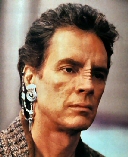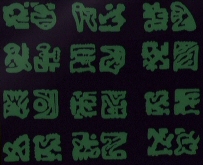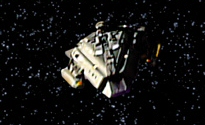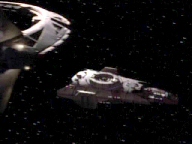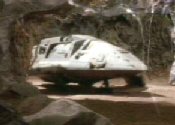Bajoran: Difference between revisions
m (added MA links) |
mNo edit summary |
||
| Line 1: | Line 1: | ||
{{Template:ILI| | {{Template:ILI| | ||
image = [[Image:Bajoran.jpg]]| | image = [[Image:Bajoran.jpg]]| | ||
| Line 8: | Line 9: | ||
|}} | |}} | ||
==Physiology== | |||
Bajorans physically resemble many of the other humanoid species of the galaxy, bearing a strong resemblance to Terrans and Betazoids. Their most distinguishing feature is a series of around five horizontal ridges on the bridge of the nose. Other key physiological differences include a heart that is mirrored along a horizontal axis rather than the vertical axis seen in the Terran heart, and a gestation period for Bajoran infants of only five months, accompanied by frenetic and uncontrollable sneezing rather than morning sickness. | |||
===Psychology=== | |||
Originally peaceful and introverted, the Bajoran people were somewhat uninterested in contact with other species. Despite one of their solar sailing craft arriving in Cardassian space as a result of tachyon winds near the Denorios Belt, Bajorans made little attempt to explore and colonise worlds further than their own system. They were neither friendly nor unfriendly with other species, instead showing courteous hospitality to those met. However, after 40 years of occupation under the Cardassian Union, the mindset of a large proportion of the Bajoran people has significantly altered. Most tend towards being courteous and hospitable, but there are many whose attitude reflects the violation that their people suffered, leaving them quick to anger, stubborn and impulsive. | |||
Bajorans share an extremely strong bond with their homeworld. It is written in an ancient proverb that “The Land and the People are One.” | |||
[[Image:Bajoranicon.jpg|right|thumb|''The Bajoran Icon.'']] | |||
[[Image:EarringLiNalas.jpg|right|thumb|''The Earring of Li Nalas.'']] | |||
[[Image:SpringWine.jpg|right|thumb|''Spring Wine.'']] | |||
==Culture and Society== | |||
The Bajoran culture is widely regarded as one of the richest in the galaxy, having had around half a million years to evolve and prosper. | |||
===Earrings=== | |||
Bajoran earrings are an indication of their faith in the Prophets. They also served other purposes, for example it has been assumed that they served to signify the d’jarra of the wearer. Many Bajorans have personalised their own earrings, indeed Kira Nerys was able to identify the earring of Li Nalas after it was delivered to Deep Space Nine by the Boslic freighter captain Rionoj early in 2370. | |||
===Food=== | |||
Bajorans enjoy a variety of different foodstuffs, the most popular of which are hasperat (a spicy wrapped dish resembling a Terran burrito), kava juice, and Spring Wine, a blue-hued alcoholic beverage brewed from kava. | |||
===Art & Music=== | |||
Art is held in high regard in Bajoran culture, and children are taught from as young as four years old. Artists often held a high position within the d’jarra system. | |||
A popular musical instrument on Bajor is the belaklavion, which is not dissimilar to a Terran clarinet in appearance. Its timbre, however is more akin to terran panpipes. The Jalanda Forum was a popular location for musical performances and dramatic entertainment up until the Occupation. Bajoran music is largely based on quartal harmony, giving it a spacious and meditational feel. | |||
===Names=== | |||
Bajorans have two names. The first is the family name, equivalent to a Terran surname. The second is a given name, equivalent to a Terran first name or Christian name. Bajorans refer to each other by their family name unless permission is given to use their given name as a form of address. For example, a Bajoran named Kenara Jor would be referred to by most people as “Kenara” and by friends and family as “Jor”. | |||
[[Image:BajoranIdeograph.jpg|right|thumb|''Example of Bajoran script.'']] | |||
===Language=== | |||
The Bajoran language is written in the form of ideographs. Key words and phrases can be found by following the links below:- | |||
[http://memory-alpha.org/en/wiki/Bajoran_language Database of commonly used Bajoran words and phrases] | |||
[http://trekbbs.com/showthread.php?p=3400244#post3400244 An analysis of the Bajoran language created by Deranged Nasat] | |||
===D’jarras=== | |||
D’jarra refers to a caste system that was in operation on Bajor during the Second Republic. Bajorans held different standings in the community based on their professions, and artists and other culturalists were held in high regard by most citizens. There is evidence to support that earrings were a symbol of d’jarra, although this is not conclusive. | |||
==Religion and Spirituality== | |||
The Bajoran spirit is referred to as the ''pagh'', which Bajorans believe is housed within the left ear. Bajoran spiritualists are known to be able to measure the strength of a pagh by gripping the ear with their hand. Bajorans are raised to follow the will of the Prophets, who promote selfless and altruistic actions. A feature of Bajoran religion is the characteristic earring, a set of two clasps connected by a chain, worn on the right ear. | |||
===Religious Heirarchy=== | |||
The Kai is the head of the Bajoran faith, and is elected by democratic means whenever circumstances require. Vedeks serve as well-regarded spiritual leaders, and form a religious assembly that advises the Kai in important religious matters. Vedeks also have access to Orbs. Prylars and Ranjens are lower-ranked monks who often work in servitude of the Kai or of Vedeks, and also maintain the sacred libraries of the Bajoran spiritual texts. The Emissary of the Prophets, while technically not a part of this religious hierarchy, is held in extremely high reverence by the Bajoran populace, and arguably has almost the same power in the Bajoran faith as does the Kai. | |||
[[Image:KaiWinn.jpg|right|thumb|''Kai Winn, spiritual leader of Bajor 2370-2375'']] | |||
{| border="1" cellpadding="2" | |||
!width="250"|Religious Titles | |||
|- | |||
|Kai | |||
|- | |||
|Vedek | |||
|- | |||
|Prylar | |||
|- | |||
|Ranjen | |||
|- | |||
|} | |||
===The Prophets=== | |||
Residing within the Celestial Temple, known to outsiders as the Bajoran wormhole, the Prophets experience time as a non-linear event. They are able to possess humanoid life-forms, and have described themselves as being “of Bajor”. The Bajoran people do not view the Prophets as aliens, rather as gods that guide their way of life. One of the Prophets possessed and guided Sara, a human, into a relationship with Joseph Sisko, resulting in the conception of Benjamin Sisko, who later became the Emissary of the Prophets after discovering the Bajoran Wormhole. | |||
[[Image:CelestialTemple.jpg|right|thumb|''The gateway to the Celestial Temple.'']] | |||
[[Image:EmissaryoftheProphets.jpg|right|thumb|''Benjamin Sisko and Vedek Winn'']] | |||
===The Emissary=== | |||
On discovering the Bajoran Wormhole along with Lieutenant-Commander Jadzia Dax in the Denorios Belt in 2369, Captain Benjamin Sisko was declared the Emissary of the Prophets by the Bajoran people. Despite developing a strong positive relationship with Kai Opaka, the contemporary leader of the Bajoran faith, Sisko initially was unwilling to embrace his role of Emissary. It was not until his belief in his position was challenged by the Prophets themselves that he began to accept his role. However, he has always acted in the best interests of the Bajoran people. | |||
While Kai Opaka embraced Sisko in his role of Emissary, her successor, Kai Winn, often treated him with jealousy and mistrust. In turn, Sisko never fully trusted Kai Winn, who eventually denounced the Prophets and aided Gul Dukat in releasing the Pagh Wraiths of the Fire Caves. | |||
===Prophecies=== | |||
Zocal’s 3rd Prophecy stated that only someone touched by the Prophets could find the ruins of B’halla. A prophecy subsequently translated from a tablet found in B’halla itself triggered the Reckoning, a cataclysmic battle between a Prophet and a Pagh wraith. It was written that, if the Prophet was victorious, Bajor would enter a golden age. The Reckoning never came to a conclusion however, as Kai Winn flooded the Promenade of Deep Space Nine, aboard which the conflict was taking place with chroniton radiation, which drove the Prophet and Pagh wraith out of their host bodies and forced them to abandon their duel. | |||
===Orbs=== | |||
The Bajoran people revere artefacts that were sent to them by the Prophets, known as Orbs, or Tears of the Prophets. Many of these were lost or plundered by the Cardassians during the Occupation, however those that have been recovered are stored in shrines across Bajor, or in the Bajoran Shrine aboard Deep Space Nine. Those known to be in the possession of the Bajorans are detailed below. | |||
[[Image:Orb.jpg|right|thumb|''An example of a Bajoran Orb.'']] | |||
{| border="1" cellpadding="2" | |||
!width="250"|The Bajoran Orbs | |||
|- | |||
|Orb of Prophecy & Change | |||
|- | |||
|Orb of Time | |||
|- | |||
|Orb of Wisdom | |||
|- | |||
|Orb of Contemplation | |||
|- | |||
|Orb of the Emissary | |||
|- | |||
|} | |||
[[Image:EmissaryofthePaghWraiths.jpg|right|thumb|''Gul Dukat as the Emissary of the Pagh Wraiths'']] | |||
===The Pagh Wraiths=== | |||
The chronicled enemies of the Prophets, the Pagh Wraiths (Bajoran: Kosst Amogen), inhabit the fire caves of Bajor. The sacred texts explain that they once resided within the Celestial Temple, but were cast out by the Prophets due to their evil tendencies. A minority of Bajorans worship the Pagh Wraiths as the true prophets of Bajor, denoted by an inverted Bajoran religious icon or a red earring which is worn on the left ear. In 2375, the Pagh Wraiths selected Cardassian Gul Dukat, the former prefect of Bajor during the Cardassian occupation, as their Emissary. During a battle with the Emissary of the Prophets, Dukat and the Pagh Wraiths were sealed inside the fire caves along with the only known means of releasing them. | |||
[[Image:RenewalScroll.jpg|right|thumb|''Burning Renewal Scrolls at the'' Gratitude Festival ''symbolically turns problems to ash.'']] | |||
===Religious Festivals=== | |||
*Days of Atonement – a time to atone for past misdemeanours through chanting, meditation and prayer. | |||
*Gratitude Festival (aka Peldor Festival) – a time to give thanks to the Prophets. Renewal scrolls are burned and Bajorans celebrate for a period of three days. | |||
*Ha’mara – a day to celebrate the arrival of the Emissary of the Prophets. | |||
*Time of Cleansing – a period of one month where Bajorans fast and abstain from worldy pleasures. | |||
===Burial Customs=== | |||
The Bajorans are less concerned with interring the remains of the deceased than they are with guiding their pagh into the afterlife. A Bajoran death chant can last up to two hours to allow for the recitation of the sacred text. In addition a duranja, or funerial candle, can be lit to act as a memorial for a loved one or friend. | |||
==Militia== | |||
Bajor's equivalent to Starfleet is the Bajoran Militia. The militia contains a large number of personnel who were active during the Resistance, as well as engineers and medics. The militia is responsible for homeworld operations as well as interplanetary and spatial operations, such as some of the maintenance of ''Deep Space Nine''. | |||
The Bajoran military hierarchy runs as follows, from lowest ranked to highest:- | |||
{| border="1" cellpadding="2" | |||
!width="250"|Militia Ranks | |||
|- | |||
|General | |||
|- | |||
|Colonel | |||
|- | |||
|Field Colonel | |||
|- | |||
|Major | |||
|- | |||
|Captain | |||
|- | |||
|1st Lieutenant | |||
|- | |||
|2nd Lieutenant | |||
|- | |||
|} | |||
The militia operates in divisions, denoted by different coloured uniforms. Command-branch officers wear terracotta and red; security wear tan and brown; engineering and ops wear grey and either green or mauve, and medical wear blue and copper. | |||
{| cellpadding="2" style="border:1px solid darkgray;" | |||
!width="150"|Command | |||
!width="150"|Security | |||
!width="150"|Engineering | |||
!width="150"|Medical | |||
|- border=0 | |||
| [[Image:BajoranCommander.jpg]] | |||
| [[Image:BajoranSecurity.jpg]] | |||
| [[Image:BajoranEngineer.jpg]] | |||
| [[Image:BajoranMedical.jpg]] | |||
|- align=center | |||
|} | |||
==Ships== | |||
Bajoran ships fall under three main specifications. | |||
[[Image:AssaultVessel.jpg|right|thumb|''A Bajoran Assault Vessel.'']] | |||
[[Image:Interceptor.jpg|right|thumb|''A Bajoran Interceptor.'']] | |||
[[Image:BajoranFreighter.jpg|right|thumb|''A Bajoran Freighter.'']] | |||
[[Image:BajoranSublight.jpg|right|thumb|''A Bajoran sub-light 2-man craft.'']] | |||
===Assault Vessels=== | |||
Assault vessels are well-armed craft designed for the defense of the planet. Members of the Circle used these craft to threaten ''Deep Space Nine'' in 2370. | |||
===Interceptors=== | |||
Interceptors are smaller craft that are highly manoeuvrable and capable of atmospheric flight. Kira Nerys commanded a blockade made up of Bajoran Interceptors to prevent the Romulans from installing weapons in an alleged medical facility in the Bajoran system in 2375. | |||
===Freighters=== | |||
Freighters are optimised for cargo transportation, although the government authorises off-world cargo ships to assist with commercial operations. Kassidy Yates and her ship Zosa were enlisted in the Bajoran Ministry of Transport. | |||
===Other=== | |||
In addition, smaller sub-light vessels were widely used during the occupation, most often holding only 2 crewmen. | |||
[[Category:Intelligent Lifeform Index Species]] | [[Category:Intelligent Lifeform Index Species]] | ||
[[Category:Permitted]] | [[Category:Permitted]] | ||
Revision as of 17:56, 24 September 2009
| Intelligent Lifeform Index |
|---|
| Bajoran | |
|---|---|

| |
| Four Letter Code | BJRN |
| Federation Status | Allied |
| Planet of Origin | Bajor |
| Encountered | TNG: Ensign Ro, (and throughout the DS9 series) |
| T/E Rating | T0/E0 |
| Current Tech Level | K+ |
| List of Named Bajorans | |

| |
Full ILI Gallery • Permitted Species Gallery | |
Physiology
Bajorans physically resemble many of the other humanoid species of the galaxy, bearing a strong resemblance to Terrans and Betazoids. Their most distinguishing feature is a series of around five horizontal ridges on the bridge of the nose. Other key physiological differences include a heart that is mirrored along a horizontal axis rather than the vertical axis seen in the Terran heart, and a gestation period for Bajoran infants of only five months, accompanied by frenetic and uncontrollable sneezing rather than morning sickness.
Psychology
Originally peaceful and introverted, the Bajoran people were somewhat uninterested in contact with other species. Despite one of their solar sailing craft arriving in Cardassian space as a result of tachyon winds near the Denorios Belt, Bajorans made little attempt to explore and colonise worlds further than their own system. They were neither friendly nor unfriendly with other species, instead showing courteous hospitality to those met. However, after 40 years of occupation under the Cardassian Union, the mindset of a large proportion of the Bajoran people has significantly altered. Most tend towards being courteous and hospitable, but there are many whose attitude reflects the violation that their people suffered, leaving them quick to anger, stubborn and impulsive. Bajorans share an extremely strong bond with their homeworld. It is written in an ancient proverb that “The Land and the People are One.”
Culture and Society
The Bajoran culture is widely regarded as one of the richest in the galaxy, having had around half a million years to evolve and prosper.
Earrings
Bajoran earrings are an indication of their faith in the Prophets. They also served other purposes, for example it has been assumed that they served to signify the d’jarra of the wearer. Many Bajorans have personalised their own earrings, indeed Kira Nerys was able to identify the earring of Li Nalas after it was delivered to Deep Space Nine by the Boslic freighter captain Rionoj early in 2370.
Food
Bajorans enjoy a variety of different foodstuffs, the most popular of which are hasperat (a spicy wrapped dish resembling a Terran burrito), kava juice, and Spring Wine, a blue-hued alcoholic beverage brewed from kava.
Art & Music
Art is held in high regard in Bajoran culture, and children are taught from as young as four years old. Artists often held a high position within the d’jarra system. A popular musical instrument on Bajor is the belaklavion, which is not dissimilar to a Terran clarinet in appearance. Its timbre, however is more akin to terran panpipes. The Jalanda Forum was a popular location for musical performances and dramatic entertainment up until the Occupation. Bajoran music is largely based on quartal harmony, giving it a spacious and meditational feel.
Names
Bajorans have two names. The first is the family name, equivalent to a Terran surname. The second is a given name, equivalent to a Terran first name or Christian name. Bajorans refer to each other by their family name unless permission is given to use their given name as a form of address. For example, a Bajoran named Kenara Jor would be referred to by most people as “Kenara” and by friends and family as “Jor”.
Language
The Bajoran language is written in the form of ideographs. Key words and phrases can be found by following the links below:-
Database of commonly used Bajoran words and phrases An analysis of the Bajoran language created by Deranged Nasat
D’jarras
D’jarra refers to a caste system that was in operation on Bajor during the Second Republic. Bajorans held different standings in the community based on their professions, and artists and other culturalists were held in high regard by most citizens. There is evidence to support that earrings were a symbol of d’jarra, although this is not conclusive.
Religion and Spirituality
The Bajoran spirit is referred to as the pagh, which Bajorans believe is housed within the left ear. Bajoran spiritualists are known to be able to measure the strength of a pagh by gripping the ear with their hand. Bajorans are raised to follow the will of the Prophets, who promote selfless and altruistic actions. A feature of Bajoran religion is the characteristic earring, a set of two clasps connected by a chain, worn on the right ear.
Religious Heirarchy
The Kai is the head of the Bajoran faith, and is elected by democratic means whenever circumstances require. Vedeks serve as well-regarded spiritual leaders, and form a religious assembly that advises the Kai in important religious matters. Vedeks also have access to Orbs. Prylars and Ranjens are lower-ranked monks who often work in servitude of the Kai or of Vedeks, and also maintain the sacred libraries of the Bajoran spiritual texts. The Emissary of the Prophets, while technically not a part of this religious hierarchy, is held in extremely high reverence by the Bajoran populace, and arguably has almost the same power in the Bajoran faith as does the Kai.
| Religious Titles |
|---|
| Kai |
| Vedek |
| Prylar |
| Ranjen |
The Prophets
Residing within the Celestial Temple, known to outsiders as the Bajoran wormhole, the Prophets experience time as a non-linear event. They are able to possess humanoid life-forms, and have described themselves as being “of Bajor”. The Bajoran people do not view the Prophets as aliens, rather as gods that guide their way of life. One of the Prophets possessed and guided Sara, a human, into a relationship with Joseph Sisko, resulting in the conception of Benjamin Sisko, who later became the Emissary of the Prophets after discovering the Bajoran Wormhole.
The Emissary
On discovering the Bajoran Wormhole along with Lieutenant-Commander Jadzia Dax in the Denorios Belt in 2369, Captain Benjamin Sisko was declared the Emissary of the Prophets by the Bajoran people. Despite developing a strong positive relationship with Kai Opaka, the contemporary leader of the Bajoran faith, Sisko initially was unwilling to embrace his role of Emissary. It was not until his belief in his position was challenged by the Prophets themselves that he began to accept his role. However, he has always acted in the best interests of the Bajoran people. While Kai Opaka embraced Sisko in his role of Emissary, her successor, Kai Winn, often treated him with jealousy and mistrust. In turn, Sisko never fully trusted Kai Winn, who eventually denounced the Prophets and aided Gul Dukat in releasing the Pagh Wraiths of the Fire Caves.
Prophecies
Zocal’s 3rd Prophecy stated that only someone touched by the Prophets could find the ruins of B’halla. A prophecy subsequently translated from a tablet found in B’halla itself triggered the Reckoning, a cataclysmic battle between a Prophet and a Pagh wraith. It was written that, if the Prophet was victorious, Bajor would enter a golden age. The Reckoning never came to a conclusion however, as Kai Winn flooded the Promenade of Deep Space Nine, aboard which the conflict was taking place with chroniton radiation, which drove the Prophet and Pagh wraith out of their host bodies and forced them to abandon their duel.
Orbs
The Bajoran people revere artefacts that were sent to them by the Prophets, known as Orbs, or Tears of the Prophets. Many of these were lost or plundered by the Cardassians during the Occupation, however those that have been recovered are stored in shrines across Bajor, or in the Bajoran Shrine aboard Deep Space Nine. Those known to be in the possession of the Bajorans are detailed below.
| The Bajoran Orbs |
|---|
| Orb of Prophecy & Change |
| Orb of Time |
| Orb of Wisdom |
| Orb of Contemplation |
| Orb of the Emissary |
The Pagh Wraiths
The chronicled enemies of the Prophets, the Pagh Wraiths (Bajoran: Kosst Amogen), inhabit the fire caves of Bajor. The sacred texts explain that they once resided within the Celestial Temple, but were cast out by the Prophets due to their evil tendencies. A minority of Bajorans worship the Pagh Wraiths as the true prophets of Bajor, denoted by an inverted Bajoran religious icon or a red earring which is worn on the left ear. In 2375, the Pagh Wraiths selected Cardassian Gul Dukat, the former prefect of Bajor during the Cardassian occupation, as their Emissary. During a battle with the Emissary of the Prophets, Dukat and the Pagh Wraiths were sealed inside the fire caves along with the only known means of releasing them.
Religious Festivals
- Days of Atonement – a time to atone for past misdemeanours through chanting, meditation and prayer.
- Gratitude Festival (aka Peldor Festival) – a time to give thanks to the Prophets. Renewal scrolls are burned and Bajorans celebrate for a period of three days.
- Ha’mara – a day to celebrate the arrival of the Emissary of the Prophets.
- Time of Cleansing – a period of one month where Bajorans fast and abstain from worldy pleasures.
Burial Customs
The Bajorans are less concerned with interring the remains of the deceased than they are with guiding their pagh into the afterlife. A Bajoran death chant can last up to two hours to allow for the recitation of the sacred text. In addition a duranja, or funerial candle, can be lit to act as a memorial for a loved one or friend.
Militia
Bajor's equivalent to Starfleet is the Bajoran Militia. The militia contains a large number of personnel who were active during the Resistance, as well as engineers and medics. The militia is responsible for homeworld operations as well as interplanetary and spatial operations, such as some of the maintenance of Deep Space Nine.
The Bajoran military hierarchy runs as follows, from lowest ranked to highest:-
| Militia Ranks |
|---|
| General |
| Colonel |
| Field Colonel |
| Major |
| Captain |
| 1st Lieutenant |
| 2nd Lieutenant |
The militia operates in divisions, denoted by different coloured uniforms. Command-branch officers wear terracotta and red; security wear tan and brown; engineering and ops wear grey and either green or mauve, and medical wear blue and copper.
| Command | Security | Engineering | Medical |
|---|---|---|---|

|

|
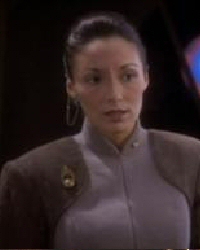
|
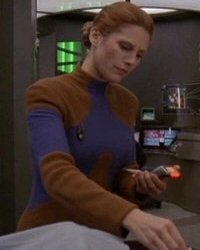
|
Ships
Bajoran ships fall under three main specifications.
Assault Vessels
Assault vessels are well-armed craft designed for the defense of the planet. Members of the Circle used these craft to threaten Deep Space Nine in 2370.
Interceptors
Interceptors are smaller craft that are highly manoeuvrable and capable of atmospheric flight. Kira Nerys commanded a blockade made up of Bajoran Interceptors to prevent the Romulans from installing weapons in an alleged medical facility in the Bajoran system in 2375.
Freighters
Freighters are optimised for cargo transportation, although the government authorises off-world cargo ships to assist with commercial operations. Kassidy Yates and her ship Zosa were enlisted in the Bajoran Ministry of Transport.
Other
In addition, smaller sub-light vessels were widely used during the occupation, most often holding only 2 crewmen.
